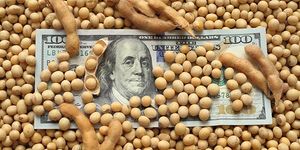Time to Price 2019 Soybeans?
 Recent soybean price volatility highlights the uncertainty underpinning the soybean market. The sudden drop last Friday gives an indication of the fragility of the current soybean market, in particular. The following factors bear watching for possible pricing opportunities during the summer months for soybeans.
Recent soybean price volatility highlights the uncertainty underpinning the soybean market. The sudden drop last Friday gives an indication of the fragility of the current soybean market, in particular. The following factors bear watching for possible pricing opportunities during the summer months for soybeans.
Issues with trade negotiations and large South American crops continue to pressure soybean use. Currently, soybean exports sit behind the pace needed to meet the projection of 1.775 billion bushels for the 2018-19 marketing year. The deterioration of trade negotiations with China places the 247 million bushels of export sales scheduled for this marketing year in question. If those sales get canceled, the potential for soybeans exports dropping below 1.6 billion bushels this marketing year increase substantially. The loss of these sales would push ending stocks well above one billion bushels.
In addition to the loss of the Chinese market, abundant South American crops look to provide stiff competition. South American production is up approximately 7 percent over last year’s crop at 6.7 billion bushels and projected production for the 2019 crop sits at 6.8 billion bushels. Weak currencies in Argentina and Brazil combined with a growing price spread over U.S. soybean export prices look to boost exports out of the region. Chinese buying out of South America last week indicates the potential shift away from U.S. soybeans from the world’s largest buyer. Weekly exports of U.S. soybeans may weaken under the increased competition. Export inspections need to average near 32 million bushels per week to hit the current USDA projection. Over the last eight weeks, export inspections averaged near 21 million bushels per week. An expectation of further reductions in the USDA estimate for soybean exports appears more likely as the trade war grinds on into the summer. Larger ending stocks associated with decreased exports create an expectation of declining prices for the summer months barring a severe weather event.
U.S. soybean planted acreage and yield will be critical factors in soybean prices moving forward. The release of the June 29 acreage report could be particularly bearish for soybean prices. The U.S. average soybean yield is projected at 49.5 bushels per acres with 84.6 million planted acres reported in USDA’s Prospective Planting report. The cold and wet planting season in the Corn Belt with the potential for reduced corn acreage could lead to an increase in planted acres in soybeans for the 2019 crop year. Despite the slow start to the planting season, the late date for prevented planting of soybeans makes the likelihood of a substantial decrease in acres due to prevent plant unlikely. Soybean acres planted as of the May 20 report sat at 19 percent which is well behind the pace of 47 percent for the five-year average. Over large areas of the Corn Belt, the prevent plant date occurs on June 10th, 15th, or the 20th. While we could see an uptick in prevented plant acres for soybeans, a large acreage decline due to prevent plant seems unlikely unless the current weather pattern continues into June.
The potential for another round of government payments adds a level of difficulty to the decision on whether to price soybeans. Currently, the administration floated some ambiguous plans for another series of payments. If those payments are tied to production like last year, the potential for a substantial increase in soybean acres rises. Slowing consumption and the prospect of increased acreage do not bode well for soybean prices during the remainder of 2019. The risks associated with waiting for a summer price rally before pricing the 2019 crop is large. Particularly if the payments floated by the government get tied to soybean production, it may be prudent to price soybeans on any near-term rally before the release of the June acreage report. Soybean acreage is more likely to surpass planting intentions creating a scenario in which production could be large even with a modest yield loss. Soybean prices appear more vulnerable to downward price movements given current supplies and the expectation of a growing crop size in 2019.
Recent cash prices for soybeans saw bids above $8 per bushel for fall delivery in central Illinois. While this price level is not at the preferred level to sell new crop soybeans, another round of payments may make this price more palatable. The alternative requires acceptance of the risks associated with further worsening in trade negotiations and potential expansion of the 2019 crop.
Source: Todd Hubbs, Farmdocdaily
